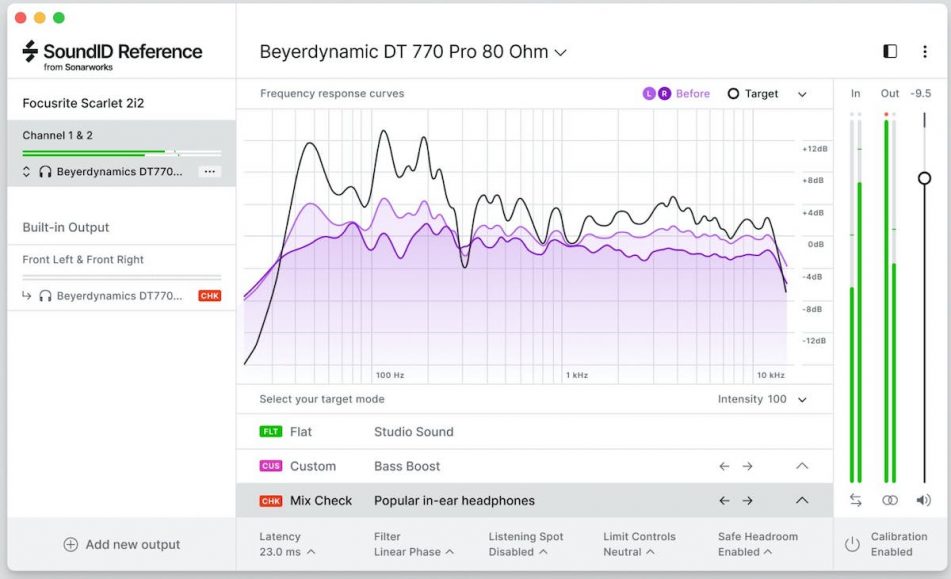
The room is 30 cubic metres – small to medium by modern standards (they’re all shrinking!).
Sonarworks reference 4 eq preset professional#
The tests are made in a professional control room with bass trapping/resonant absorbers and wideband absorbers built into the walls, and quadratic diffusers behind the monitors. The monitors are fed with a Lavry DA10 converter via a Mackie Big Knob for volume control. The measurement mics are recorded through a Focusrite ISA828, the most transparent preamp in ourstudio, and the AD conversion comes via an Antelope Audio Orion 32 interface. The iPad app NeumannControl controls the monitors’ DSP features but we don’t use that for our tests. The group test is carried out with a pair of Neumann KH 80 DSP 2-way active nearfield monitors.

The XREF mic is supplied with a serial-number-specific calibration file that can be downloaded for use in other products, in this case TRACT and Dirac Live.

We test ARC 3 with the MEMS measurement microphone it’s supplied with, while the others were set up using Sonarworks’ XREF 20 microphone.
Sonarworks reference 4 eq preset software#
We’re using four room-correction software products as part of our group test: IK Multimedia ARC System 3, Sonarworks Reference 4 Studio Edition, Dirac Live and Waves TRACT. The resulting map or profile can be used to create compensatory EQ curves and phase shifts. Save the file as "Focal Clear flat bass.Room-correction software can take measurements from various points in a room and assess how the amplitude and phase shift of discrete frequency bands compare before and after exiting a monitor system. Alternatively use ~87 Hz at the limit if you want to keep the upper bass / lower mid hump.ĥ. (Focal Clear error touches zero at 500 Hz). Remove all other columns but frequency and errorģ. Open Focal Clear result CSV file in excelĢ. Other way would be to create a new sound signature file:ġ. You'll be needing 12 filters but if you're using EqualizerAPO, that won't be a problem. One option would be to equalize to Clear and then add the two filters I gave you on top of the 10 filters produced for the transformation. There isn't a simple way to equalize on headphone to other headphone while keeping the Harman bass shelf shape. In other words the -bass_boost parameter doesn't directly affect the parametric eq filters. Parametric eq filters are then later optimized in such a way that they get as close to the target as possible. If I wanted to then equalize my HE4XX to the sound signature of the Focal Clear with the +4dB Harman bass shelf, would there be an easy way to do that? Basically what I'm aiming for is a sound signature following the Harman target from ~200Hz and below (or at whichever frequency the Harman bass shelf ends) but following the Focal Clear's frequency response from ~201Hz and above, like a "chimeric" sound signature (and maybe also experiment with the Hz value for the chimeric boundary, if that's possible).Ĭlick to expand.-bass_boost sets the target level for the bass shelf. So, for a 4dB bass boost, I thought the result would just be a peaking filter at 33 Hz with gain 4.0 dB and Q 0.42, but I haven't tested this command and I honestly don't know anything about how parametric EQs or peaking filters work in tandem with each other.

Thanks for everything, and if you have time please let me know!įilter 1: ON PK Fc 33 Hz Gain 1.7 dB Q 0.42Īnd from this I assumed that modulating -bass_boost in AutoEQ would result in a peaking filter at 33Hz, Q 0.42 with the specified dB value (and I thought that bass bleed into the mids wouldn't be taken into account by the -bass_boost argument, since there was no Filter 2 generated at around 200Hz with a negative gain). I guess I'm just wondering why this happens. I played around some more and found that if I use the same compensation, sound signature, and bass boost but a different headphone's (e.g., Sennheiser HD 600) measurement input_dir, the target curve shifts up/down (but retains the same general shape), so I'm sure there's a very good reason for why this is the case. However, when looking at the automatically-generated graphs, the target curves are different (but the general shape is the same). I thought that since the compensation, sound signature, and bass boost are the same for both commands, the target curve should be the same for both results. Python autoeq.py -input_dir="measurements\oratory1990\data\onear\HIFIMAN HE400i 2020" -output_dir="my_results\ HE400i 2020 to Focal Clear (1.7dB Bass Boost)” -compensation="compensation\harman_over-ear_2018_wo_bass.csv" -sound_signature=”results\oratory1990\harman_over-ear_2018\Focal Clear\Focal Clear.csv” -equalize -parametric_eq -max_filters=10 -bass_boost=5.7 -max_gain=25


 0 kommentar(er)
0 kommentar(er)
